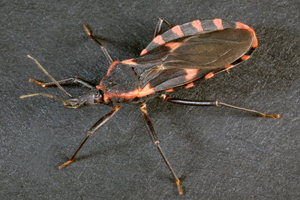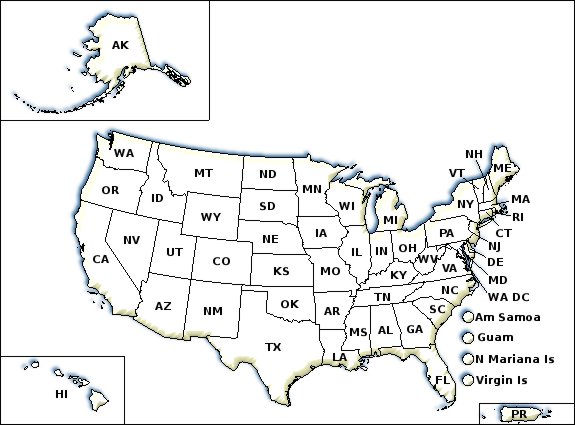Kissing Bugs
1.800.858.7378npic@oregonstate.edu
We're open from 8:00AM to 12:00PM Pacific Time, Mon-Fri
A to Z
Kissing Bugs
Kissing Bugs

Kissing bugs, often referred to as cone-nose bugs, are insects found between the southern United States and South America. Kissing bugs can be disease vectors, meaning they can carry and transmit disease. These bugs need blood to survive, and are known to feed on rodents, bats, birds, pets, and humans. Few types of kissing bugs live in people's homes, but geography and animals may encourage them to do so.
Kissing bugs take shelter during the day, and feed at night, which is how people get bitten while sleeping. Kissing bugs can affect humans and pets by transmitting the Trypanosoma cruzi parasite through their feces, the cause of Chagas disease. This happens only rarely in the United States. Not all bugs can lead to infection because relatively few of them carry the parasite. A rash or allergic reaction to a bite does not mean you’ve been infected.
Kissing bugs start their life without wings and are less than 1/10 of an inch in size, but grow wings and become bigger as adults (3/4 - 1 1/4 inch). Adults can produce a strong odor when bothered, similar to stink bugs.
Control tips:
- If you suspect you may have kissing bugs, check for clues like feces and eggs. Feces may be spread on walls and can be both white and dark, and usually look like stripes. Eggs can be found in wall crevices and are mostly white or pinkish.
- Consider using an Integrated Pest Management (IPM) approach including sealing cracks and gaps to prevent kissing bugs from entering your home. Check windows, walls, roofs, and doors. Use screens on doors and windows.
- Kissing bugs may hide where you and your pets sleep. Wash fabrics and bedding in hot water or dry on high heat.
- Vacuum carpets, pet areas, and baseboard crevices to remove larvae and eggs. Vacuum mattresses and under bedroom furniture.
- Kissing bugs can be attracted by light. Consider turning off lights near homes and kennels at night.
- Kissing bugs may live with rodents. Discourage kissing bugs and rodents by removing yard debris and keeping vegetation low. Remove wood, brush, and rock piles or other places rodents may live.
- If you find a bug you suspect to be a kissing bug, don't touch it. Capture it using a jar or plastic bag and freeze it to keep it in good shape for later identification.
- Your local cooperative extension service may be able to provide information about kissing bug presence in your area, identification, and control methods.
If you are unable to locate your county extension office, or if you have questions about product(s) you may be considering, please call NPIC at 800-858-7378 (8:00am - 12:00pm PST), or email us at npic@ace.orst.edu.
Kissing Bugs
- Identify your pest. Are you sure you're dealing with a kissing bug?
- Kissing bugs can be attracted by light. Consider turning off lights near homes and kennels at night.
- Seal cracks and gaps to prevent kissing bugs from entering your home. Check windows, walls, roofs, and doors. Use screens on doors and windows.
- Kissing bugs may hide where you and your pets sleep. Wash fabrics and bedding in hot water or dry on high heat.
- Vacuum carpets, pet areas, and baseboard crevices. Vacuum mattresses, and under bedroom furniture.
- Kissing bugs may live with rodents. Remove debris from your yard and keep vegetation low. Remove wood, brush, and rock piles.
If you choose to use a pesticide, read the label before you buy. Try a lower toxicity product first.
If you have a pesticide product in mind, have your label handy and click here for information about that product.
County Extension Offices
Through its county agents, the Cooperative Extension Service gives individuals access to the resources at land-grant universities across the nation. These universities are centers for research in many subjects, including entomology (the study of insects) and agriculture. Each county within the United States has an Extension office, which is staffed with agents who work closely with university-based Extension specialists to deliver answers to your questions about gardening, agriculture, and pest control. You can find the phone number for your local county extension office in the local government section (often marked with blue pages) of your telephone directory or by clicking on the map below.

U.S. States:
AK | AL | AR | AZ | CA | CO | CT | DE | FL | GA | HI | IA | ID | IL | IN | KS | KY | LA | MA | MD | ME | MI | MN | MO | MS | MT | NC | ND | NE | NH | NJ | NM | NV | NY | OH | OK | OR | PA | RI | SC | SD | TN | TX | UT | VA | VT | WA | WI | WV | WY | Washington D.C. |
U.S. Territories:
Puerto Rico | American Samoa | Guam | Northern Mariana Islands | Virgin Islands
Additional Resources:
- Information on Species of Triatomine Bugs in the United States - Center for Disease Control and Prevention
- Kissing Bugs & Chagas Disease in the United States - Texas A&M University
- Parasites: American Trypanosomiasis (aka Chagas Disease) - Center for Disease Control and Prevention
- Conenose or Kissing Bugs - Texas A&M University
- Conenose bugs - University of California Statewide IPM Program
- Kissing Bugs & Chagas Disease: What You Need to Know - UTHealth School of Public Health
